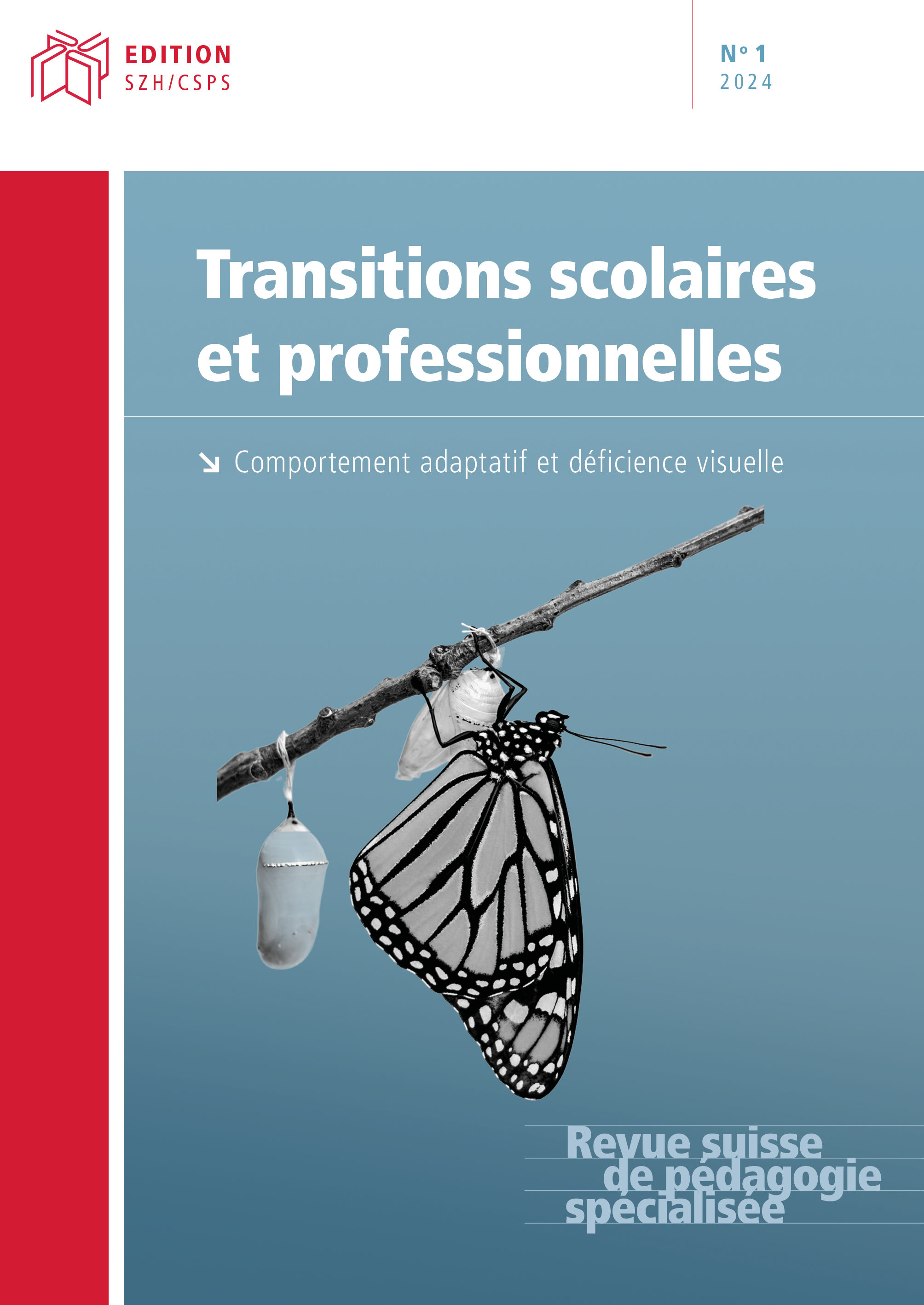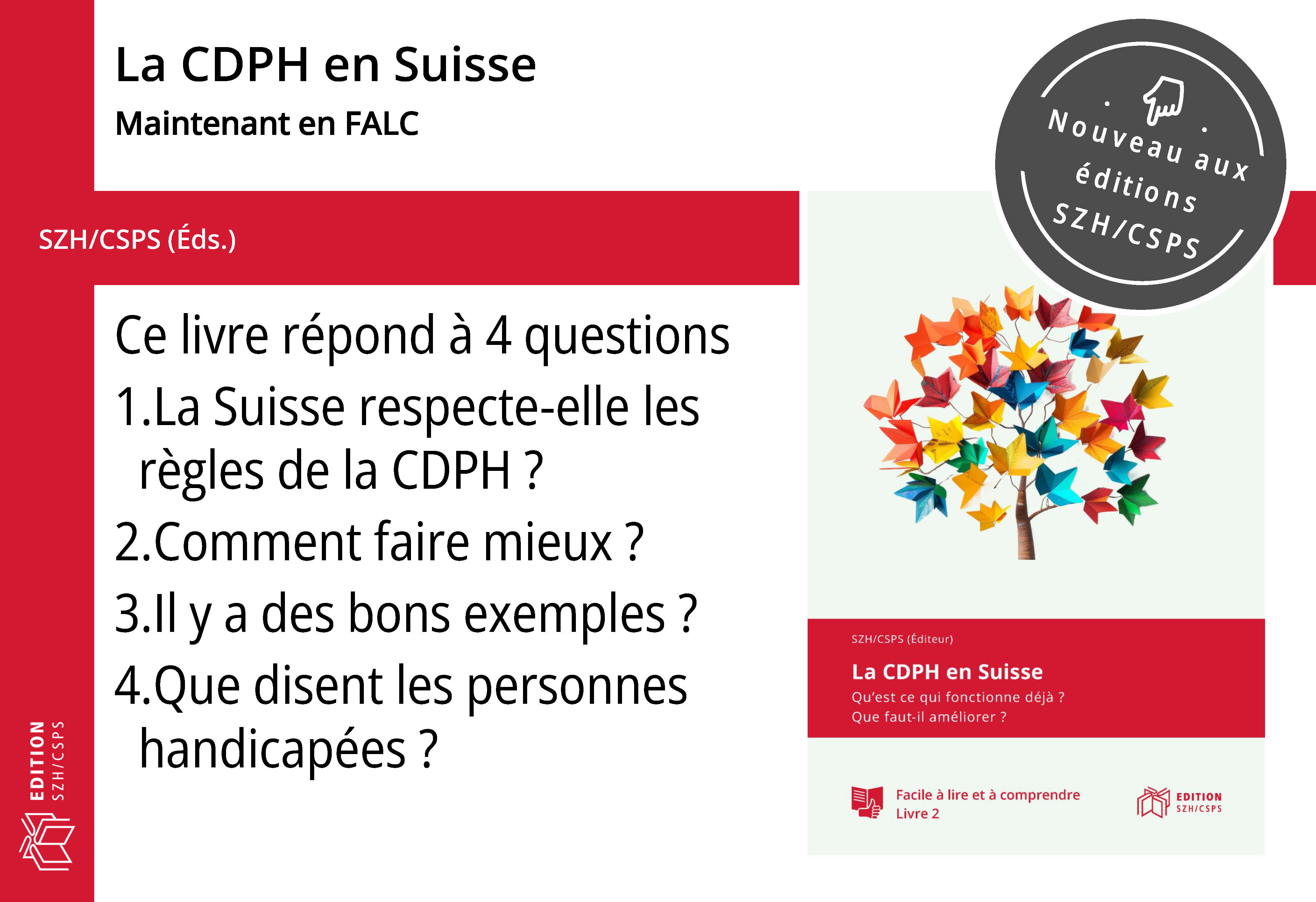Le comportement adaptatif des enfants et des jeunes présentant une déficience visuelle
Examen de la portée (Scoping Review)
DOI:
https://doi.org/10.57161/r2024-01-08Schlagworte:
adaptives Verhalten, SehbehinderungAbstract
Sehbehinderungen, die ein Spektrum von Low Vision bis hin zu völliger Blindheit umfassen, können das adaptive Verhalten unterschiedlich beeinflussen. In diesem Sinn kann es nützlich sein, das adaptive Verhalten anhand validierter Instrumente sowohl im Interventions- als auch im Forschungskontext zu bewerten. Denn diese Bewertung ermöglicht es, Individuen in Bezug auf die Norm zu verorten und prioritäre Lernprozesse zu bestimmen. Dieser Artikel fasst die wissenschaftlichen Erkenntnisse anhand einer Literaturübersicht (scoping review) zusammen, in welcher neun Artikel analysiert wurden, die sich mit diesem Thema befassten. Es zeigt sich einerseits die Tendenz, dass das adaptive Verhalten bei Personen mit einer Sehbehinderung häufig tiefer ausfällt als bei sehenden Gleichaltrigen. Gleichzeitig wurden aber auch Unterbereiche identifiziert, die Stärken aufzeigen.
Literaturhinweise
* Les références précédées par un astérisque ont été analysées dans cette revue de littérature.
*Bathelt, J., de Haan, M., & Dale, N. J. (2019). Adaptive behaviour and quality of life in school-age children with congenital visual disorders and different levels of visual impairment. Research in Developmental Disabili-ties, 85, 154–162. https://doi.org/10.1016/j.ridd.2018.12.003
Bless, G., & Orthmann-Bless, D. (2022). Rapport final sur la situation actuelle des enfants malvoyants/sourdaveugles en Suisse. Une étude réalisée dans le cadre de REVISA – dépistage et reconnaissance des déficiences visuelles à l’âge (pré)scolaire. Institut de pédagogie curative de l’Université de Fribourg. https://www.ucba.ch/fileadmin/pdfs/Forschung/Forschung_FR/Forschungsberichte/Schulalter/Orthmann_Bless_D.__Bless_G.__2022__REVISA_La_situation_actuelle.pdf
Brian, A., Starrett, A., Pennell, A., Haibach-Beach, P., Gilbert, E., Stribing, A., Miedema, S. T., & Lieberman, L. (2021). Longitudinal locomotor competence and body mass index across self-reported gender and vision level for youth with visual impairments: A 3-year investigation. Adapted Physical Activity Quarterly, 38(2), 268–285. https://doi.org/10.1123/apaq.2020-0082
Caron, V., Allegranza, L., Lieberman, L., & Haibach-Beach, P. (2023). Camp Abilities – an educational sports camp for children and youth with visual impairment: A systematic review. British Journal of Visual Impair-ment. https://doi.org/10.1177/02646196231187543
*Celeste, M. (2006). Play Behaviors and Social Interactions of a Child Who Is Blind: In Theory and Practice. Jour-nal of Visual Impairment and Blindness, 100(2), 75-90. https://doi.org/10.1177/0145482X0610000203
*Celeste, M., & Grum, D. K. (2010). Social integration of children with visual impairment: A developmental mo-del. Elementary Education Online, 9(1), 11-22. http://ilkogretim-online.org.tr
Floyd, R. G., Shands, E. I., Alfonso, V. C., Phillips, J. F., Autry, B. K., Mosteller, J. A., Skinner, M., & Irby, S. (2015). A Systematic Review and Psychometric Evaluation of Adaptive Behavior Scales and Recommendations for Practice. Journal of Applied School Psychology, 31(1), 83-113. https://doi.org/10.1080/15377903.2014.979384
*Greenaway, R., Pring, L., Schepers, A., Isaacs, D. P., & Dale, N. J. (2017). Neuropsychological presentation and adaptive skills in high-functioning adolescents with visual impairment: A preliminary investigation. Ap-plied Neuropsychology: Child, 6(2), 145-157. https://doi.org/10.1080/21622965.2015.1129608
*Grum, D. K., Kakizawa, T., & Celeste, M. (2014). Assessment of play behaviours and social interactions of two blind girls: Case studies in Japan. Anthropological Notebooks, 20(2), 61-76. https://anthropological-notebooks.zrc-sazu.si/Notebooks/article/view/191
Haegele, J. A., Brian, A., & Goodway, J. (2015). Fundamental motor skills and school-aged individuals with visual impairments: A review. Review Journal of Autism and Developmental Disorders, 2(3), 320-327. https://doi.org/10.1007/s40489-015-0055-8
Harrison, P. L., & Oakland, T. (2008). Adaptive Behavior Assessment System (2nd ed.). Western Psychologi-cal Services.
Harrison, P. L., & Oakland, T. (2015). Adaptive Behavior Assessment System (3rd ed.). Western Psychologi-cal Services.
Jonker, F., de Looff, P., van Erp, S., Nijman, H., & Didden, R. (2023). The adaptive ability performance test (ADAPT): A factor analytic study in clients with intellectual disabilities. Journal of Applied Research in Intel-lectual Disabilities, 36(1), 3-12. https://doi.org/10.1111/jar.13044
Lewis, S., & Iselin, S. A. (2002). A Comparison of the Independent Living Skills of Primary Students with Visual Impairments and Their Sighted Peers: A Pilot Study. Journal of Visual Impairment and Blindness, 96(5), 335-344. https://doi.org/10.1177/0145482X0209600505
Mosca, R., Kritzinger, A., & van der Linde, J. (2015). Language and communication development in preschool children with visual impairment: A systematic review. The South African journal of communication disor-ders, 62(1), 1-10. https://doi.org/10.4102/sajcd.v62i1.119
*Metsiou, K., Papadopoulos, K., & Agaliotis, I. (2011). Adaptive behavior of primary school students with visual impairments: The impact of educational settings. Research in Developmental Disabilities, 32(6), 2340–2345. https://doi.org/10.1016/j.ridd.2011.07.030
Munn, Z., Peters, M. D. J., Stern, C., Tufanaru, C., McArthur, A., & Aromataris, E. (2018). Systematic review or scoping review? Guidance for authors when choosing between a systematic or scoping review approach. BMC Medical Research Methodology, 18(1). https://doi.org/10.1186/s12874-018-0611-x
Organisation Mondiale de la santé [OMS]. (2023). Cécité et déficience visuelle. https://www.who.int/fr/news-room/fact-sheets/detail/blindness-and-visual-impairment
*Parson, S. (1987). Locus of Control and Adaptive Behavior in Visually Impaired Children. Journal of Visual Im-pairment and Blindness,81(9), 429-432. https://psycnet.apa.org/record/1988-37364-001
*Papadopoulos, K., Metsiou, K., & Agaliotis, I. (2011). Adaptive behavior of children and adolescents with visual impairments. Research in Developmental Disabilities, 32(3), 1086-1096. https://doi.org/10.1016/j.ridd.2011.01.021
*Pineio, C., Eleni, F., Spyridon-Georgios, S., Konstantinos, C., Foteini, C., & Eleni, C. (2019). Relationship of Motor Development to Adaptative Behavior of Children and Adolescents with Visual Impairment. European. Journal of Special Education Research, 4(4), 115-131. https://doi.org/10.5281/zenodo.3379031
Pontrelli Mecca, T., Tafla, T. L., Bueno, F. M. B., Valentini, F., Bassetto, S. A., & Teixeira, M. C. T. V. (2022). Trans-cultural adaptation of the Adaptive Behavior Assessment System (ABAS-3). International Journal of Deve-lopmental Disabilities, 1-11. https://doi.org/10.1080/20473869.2022.2137953
Schalock, R. L., Luckasson, R.., & Tassé, M. J. (2021). Intellectual disability: Definition, diagnosis, classification, and systems of supports (12th ed.). American Association on Intellectual and Developmental Disabilities.
Sparrow, S. S., Balla, D. A., & Cicchetti, D. V. (1984). The Vineland Adaptive Behavior Scales. American Guidance Service.
Sparrow, S. S., Cicchetti, D. V., & Balla, D. A. (2005). Vineland Adaptive Behavior Scales (2nd ed.). American Gui-dance Service.
Sparrow, S. S., Cicchetti, D. V., & Saulnier, C. A. (2016). Vineland Adaptive Behavior Scales, Third Edition (3rd ed.). Pearson.
van der Aa, H., Jonker, F., de Looff, P., & Didden, R. (2023). A Study into the Relationship Between Adaptive Skills and Visual Impairment in Individuals with and Without Intellectual Disabilities. Journal of Visual Impair-ment & Blindness, 117(3), 224-232. https://doi.org/10.1177/0145482x231180615
Veldhorst, C., Vervloed, M., Kef, S., & Steenbergen, B. (2022). A scoping review of longitudinal studies of chil-dren with vision impairment. British Journal of Visual Impairment, 41(3), 587-609. https://doi.org/10.1177/02646196211072432
Veröffentlicht
Zitationsvorschlag
Ausgabe
Rubrik
Lizenz
Copyright (c) 2024 Valérie Caron, Stefania Garbellini, Geneviève Petitpierre

Dieses Werk steht unter der Lizenz Creative Commons Namensnennung 4.0 International.



